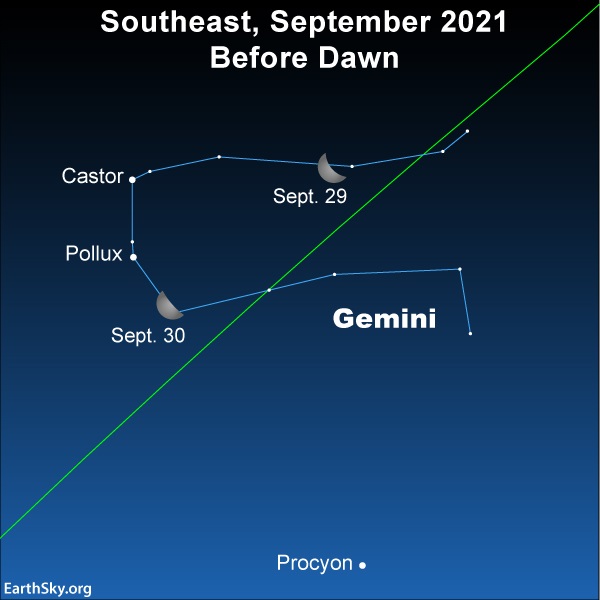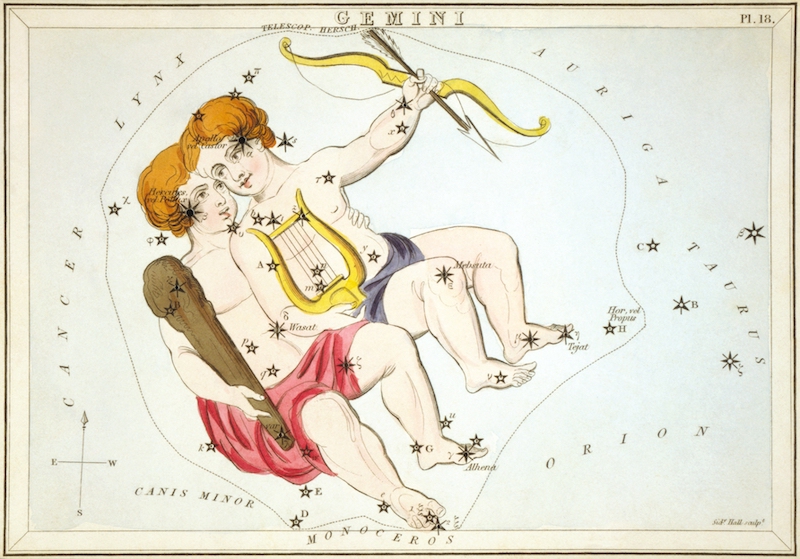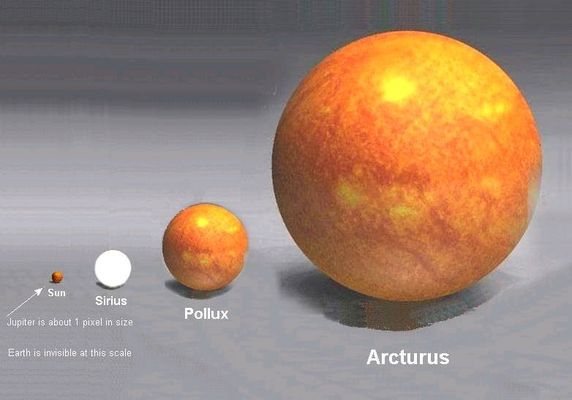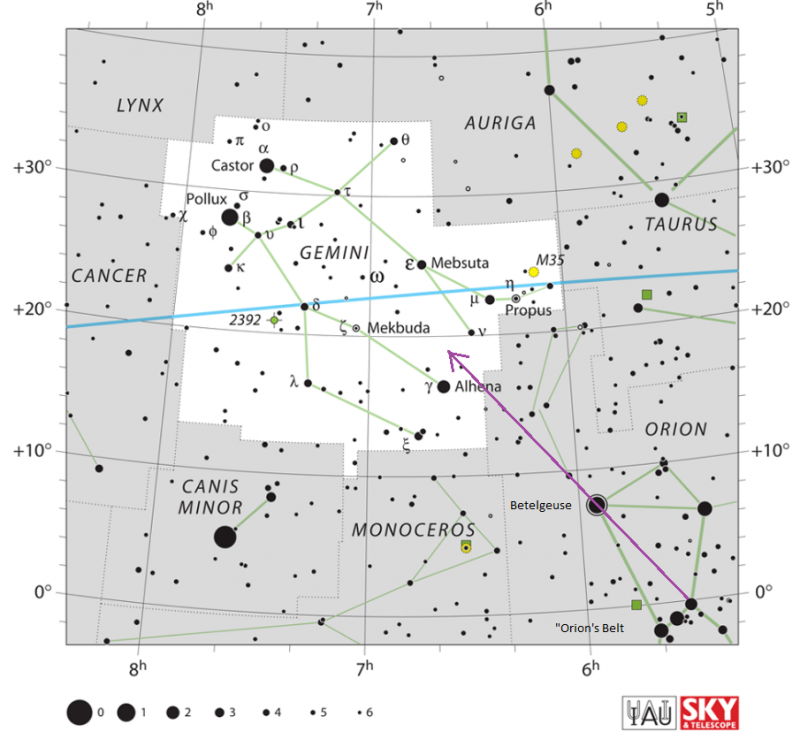
Last quarter moon in Gemini
On the mornings of September 29 and 30, 2021, you can see the moon near the two brightest stars of the constellation Gemini the Twins. These stars are Castor and Pollux. The moon will reach its last quarter phase in front of Gemini on September 29 at 01:57 UTC. By clocks in North America, that translates to the evening of September 28. A last quarter moon is a waning moon. So the September 28-29 moon will look half-illuminated, like half a pie. And the next night’s moon will look slimmer, like a fat crescent.
See how bright Castor and Pollux are, and how close together? Even without the moon, they’re noticeable on the sky’s dome.
A last quarter moon rises in the middle of the night, maybe after your bedtime. Find out the moon’s rising time in your sky via the Old Farmer’s Almanac (U.S. and Canada) or timeanddate.com (worldwide). Find out the moon’s position relative to the constellations of the zodiac via Heavens-Above.

Gemini, constellation of the Twins
Gemini is the constellation of the Twins, and Castor and Pollux are often called “twin” stars. But these two stars aren’t twins; they’re really very different. Although Castor and Pollux appear close, they’re not physically related or close together in space. Pollux, the closer star, lies about 34 light-years away, while Castor resides at a distance of about 52 light-years.
If you scrutinize Castor and Pollux, you might discern their difference in color. Castor appears white in contrast to the orange glow of Pollux. A white star is a relatively hot star in the heyday of youth. An orange star is a cool star in the autumn of its years.
Pollux is a giant star
Moreover, Pollux’s orange color reveals that it’s a giant star. According to the star expert Jim Kaler, any star with the mass of 0.8 to 5 times the sun’s swells up and becomes a giant star in old age.
Pollux, the nearest giant star to Earth, has a diameter of about 10 of our suns. It’s also one of the very few giant stars known to harbor a planet.
Castor is six stars in one
The other “twin,” Castor, is remarkable in its own right. Castor is actually six stars in one, consisting of 3 pairs of binary stars, all revolving around a common center of mass.
By the way, the moon will move out of the constellation Gemini and into the faint constellation Cancer the Crab on or near October 1, 2021.

Use Orion’s Belt to locate Castor and Pollux
Even with no moon to guide you, however, you can notice Castor and Pollux for their brightness and nearness to each other on the sky’s dome. Not sure you have the right stars? Try using Orion’s Belt to star-hop to Castor and Pollux (see the sky chart below):

Bottom line: On September 29 and 30, 2021, use the waning crescent moon to find the Gemini stars Castor and Pollux.
The post Moon in Gemini before dawn September 29 and 30 first appeared on EarthSky.
from EarthSky https://ift.tt/3o9nR34

Last quarter moon in Gemini
On the mornings of September 29 and 30, 2021, you can see the moon near the two brightest stars of the constellation Gemini the Twins. These stars are Castor and Pollux. The moon will reach its last quarter phase in front of Gemini on September 29 at 01:57 UTC. By clocks in North America, that translates to the evening of September 28. A last quarter moon is a waning moon. So the September 28-29 moon will look half-illuminated, like half a pie. And the next night’s moon will look slimmer, like a fat crescent.
See how bright Castor and Pollux are, and how close together? Even without the moon, they’re noticeable on the sky’s dome.
A last quarter moon rises in the middle of the night, maybe after your bedtime. Find out the moon’s rising time in your sky via the Old Farmer’s Almanac (U.S. and Canada) or timeanddate.com (worldwide). Find out the moon’s position relative to the constellations of the zodiac via Heavens-Above.

Gemini, constellation of the Twins
Gemini is the constellation of the Twins, and Castor and Pollux are often called “twin” stars. But these two stars aren’t twins; they’re really very different. Although Castor and Pollux appear close, they’re not physically related or close together in space. Pollux, the closer star, lies about 34 light-years away, while Castor resides at a distance of about 52 light-years.
If you scrutinize Castor and Pollux, you might discern their difference in color. Castor appears white in contrast to the orange glow of Pollux. A white star is a relatively hot star in the heyday of youth. An orange star is a cool star in the autumn of its years.
Pollux is a giant star
Moreover, Pollux’s orange color reveals that it’s a giant star. According to the star expert Jim Kaler, any star with the mass of 0.8 to 5 times the sun’s swells up and becomes a giant star in old age.
Pollux, the nearest giant star to Earth, has a diameter of about 10 of our suns. It’s also one of the very few giant stars known to harbor a planet.
Castor is six stars in one
The other “twin,” Castor, is remarkable in its own right. Castor is actually six stars in one, consisting of 3 pairs of binary stars, all revolving around a common center of mass.
By the way, the moon will move out of the constellation Gemini and into the faint constellation Cancer the Crab on or near October 1, 2021.

Use Orion’s Belt to locate Castor and Pollux
Even with no moon to guide you, however, you can notice Castor and Pollux for their brightness and nearness to each other on the sky’s dome. Not sure you have the right stars? Try using Orion’s Belt to star-hop to Castor and Pollux (see the sky chart below):

Bottom line: On September 29 and 30, 2021, use the waning crescent moon to find the Gemini stars Castor and Pollux.
The post Moon in Gemini before dawn September 29 and 30 first appeared on EarthSky.
from EarthSky https://ift.tt/3o9nR34

Aucun commentaire:
Enregistrer un commentaire